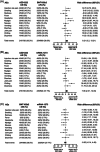Effects of boosted mRNA and adenoviral-vectored vaccines on immune responses to omicron BA.1 and BA.2 following the heterologous CoronaVac/AZD1222 vaccination
- PMID: 35924475
- PMCID: PMC9538512
- DOI: 10.1002/jmv.28044
Effects of boosted mRNA and adenoviral-vectored vaccines on immune responses to omicron BA.1 and BA.2 following the heterologous CoronaVac/AZD1222 vaccination
Abstract
The coronavirus 2019 omicron variant has surged rapidly and raises concerns about immune evasion even in individuals with complete vaccination, because it harbors mutations. Here we examine the capability of booster vaccination following CoronaVac/AZD1222 prime to induce neutralizing antibodies (NAbs) against omicron (BA.1 and BA.2) and T-cell responses. A total of 167 participants primed with heterologous CoronaVac/AZD1222 for 4-5 months were enrolled, to receive AZD1222, BNT162b2, or mRNA-1273 as a third dose. Reactogenicity was recorded. Immunogenicity analyses of severe acute respiratory syndrome coronavirus 2-binding antibodies were measured using enzyme-linked immunosorbent assay. The NAb titers against omicron BA.1 and BA.2 were determined using the focus reduction neutralization test (FRNT50) and total interferon-γ responses were measured to observe the T-cell activation. A substantial loss in neutralizing potency to omicron variant was found at 4-5 months after receiving the heterologous CoronaVac/AZD1222. Following booster vaccination, a significant increase in binding antibodies and neutralizing activities toward delta and omicron variants was observed. Neutralization to omicron BA.1 and BA.2 were comparable, showing the highest titers after boosted mRNA-1273 followed by BNT162b2 and AZD1222. In addition, individuals boosted with messenger RNA (mRNA) vaccines develop a T-cell response to spike protein, whereas those boosted with AZD1222 did not. Reactogenicity was mild to moderate without serious adverse events. Our findings demonstrated that mRNA booster vaccination is able to overcome waning immunity to provide antibodies that neutralize omicron BA.1 and BA.2, as well as a T-cell response.
Keywords: AZD1222; COVID-19; booster vaccine; heterologous; mRNA vaccine; omicron.
© 2022 Wiley Periodicals LLC.
Conflict of interest statement
The authors declare no conflict of interest.
Figures





Similar articles
-
Persistence of immunity against Omicron BA.1 and BA.2 variants following homologous and heterologous COVID-19 booster vaccines in healthy adults after a two-dose AZD1222 vaccination.Int J Infect Dis. 2022 Sep;122:793-801. doi: 10.1016/j.ijid.2022.07.038. Epub 2022 Jul 19. Int J Infect Dis. 2022. PMID: 35863731 Free PMC article.
-
Neutralizing Activities Against the Omicron Variant After a Heterologous Booster in Healthy Adults Receiving Two Doses of CoronaVac Vaccination.J Infect Dis. 2022 Oct 17;226(8):1372-1381. doi: 10.1093/infdis/jiac092. J Infect Dis. 2022. PMID: 35267040
-
The immunogenicity and reactogenicity of four COVID-19 booster vaccinations against SARS-CoV-2 variants following CoronaVac or ChAdOx1 nCoV-19 primary series.Asian Pac J Allergy Immunol. 2024 Sep;42(3):276-289. doi: 10.12932/AP-160123-1533. Asian Pac J Allergy Immunol. 2024. PMID: 37466962
-
Longevity of immunity following COVID-19 vaccination: a comprehensive review of the currently approved vaccines.Hum Vaccin Immunother. 2022 Nov 30;18(5):2037384. doi: 10.1080/21645515.2022.2037384. Epub 2022 Apr 13. Hum Vaccin Immunother. 2022. PMID: 35417285 Free PMC article. Review.
-
The humoral and cellular immune evasion of SARS-CoV-2 Omicron and sub-lineages.Virol Sin. 2022 Dec;37(6):786-795. doi: 10.1016/j.virs.2022.11.007. Epub 2022 Nov 23. Virol Sin. 2022. PMID: 36427646 Free PMC article. Review.
Cited by
-
Safety and Efficacy of a Third Dose of the BNT162b2 Vaccine in Liver-Transplanted and Healthy Adolescents.JPGN Rep. 2023 Oct 9;4(4):e373. doi: 10.1097/PG9.0000000000000373. eCollection 2023 Nov. JPGN Rep. 2023. PMID: 38034438 Free PMC article.
-
Immunogenicity after a Third COVID-19 mRNA Booster in Solid Cancer Patients Who Previously Received the Primary Heterologous CoronaVac/ChAdOx1 Vaccine.Vaccines (Basel). 2022 Sep 26;10(10):1613. doi: 10.3390/vaccines10101613. Vaccines (Basel). 2022. PMID: 36298478 Free PMC article.
-
Strong Correlations between the Binding Antibodies against Wild-Type and Neutralizing Antibodies against Omicron BA.1 and BA.2 Variants of SARS-CoV-2 in Individuals Following Booster (Third-Dose) Vaccination.Diagnostics (Basel). 2022 Jul 22;12(8):1781. doi: 10.3390/diagnostics12081781. Diagnostics (Basel). 2022. PMID: 35892491 Free PMC article.
-
Impact of Prior COVID-19 Immunization and/or Prior Infection on Immune Responses and Clinical Outcomes.Viruses. 2024 Apr 26;16(5):685. doi: 10.3390/v16050685. Viruses. 2024. PMID: 38793566 Free PMC article. Review.
-
SARS-CoV-2 Antibody Dynamics after COVID-19 Vaccination and Infection: A Real-World Cross-Sectional Analysis.Vaccines (Basel). 2023 Jun 30;11(7):1184. doi: 10.3390/vaccines11071184. Vaccines (Basel). 2023. PMID: 37515001 Free PMC article.
References
-
- World Health Organization . 2022. Classification of Omicron (B.1.1.529): SARS‐CoV‐2 Variant of Concern. Accessed June 30, https://www.who.int/news/item/26-11-2021-classification-of-omicron-(b.1....
-
- World Health Organization . 2022. Accessed June 30, 2022. https://covid19.who.int
-
- Larrauri BJ, Malbrán A, Larrauri JA. Omicron and vaccines: an analysis on the decline in COVID‐19 mortality. medRxiv . 2022. 10.1101/2022.05.20.22275396 - DOI
Publication types
MeSH terms
Substances
Supplementary concepts
Associated data
LinkOut - more resources
Full Text Sources
Medical

